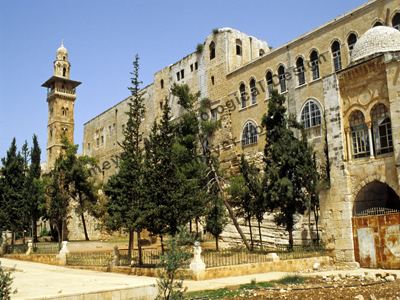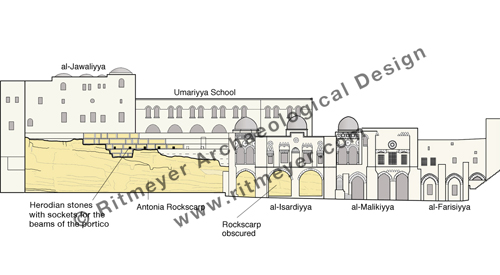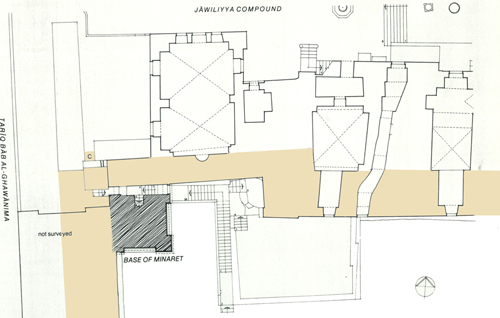In our previous post, we wrote about the archaeological remains at the northwest part of the Temple Mount, most of which are now buried under a thick layer of earth. Most of the notable Herodian remains in this corner of the mount, however, can still be seen above ground level in the area where the Ghawanima minaret stands today.

Here stood the Antonia, the large fortress at the northwest corner of the Temple Mount, which was built by Herod the Great when he extended the pre-Herodian square Temple Mount to its present size. He named it after his friend Mark Antony. According to Josephus, it was located where the western and northern porticoes met.

In the Acts of the Apostles, chapters 21 and 22, we read that the Apostle Paul went up and came down several times from this fortress, called in the New Testament the “castle” or “barracks”. The events described here took place when Paul was falsely accused in the Temple Mount of bringing a Gentile into the Sanctuary. A great commotion among the Jews ensued, with Paul being carried up the steps of the Antonia (21.35) by a unit of Roman soldiers that had earlier come down from the fortress (21.32). The only place from which the soldiers could have run down to the Temple Mount was the Antonia Fortress.
The Roman captain, Lysias, allowed Paul to address his fellow countrymen from the safety of the Antonia, probably from the top of the north portico, traces of which still be seen today. Paul delivered his impassioned defense in the Hebrew tongue before he was led into the Antonia. In the courtyard of this fortress, he was bound with cords and prepared for scourging, which was only averted by his appealing to his Roman citizenship. The next day, Paul was brought down from the fortress to the Temple Mount to stand before the Sanhedrin (22.30). After giving an account of his faith, the Roman soldiers came down again from the Antonia in order to bring Paul back up again. The last time that Paul descended from the Antonia was when he was taken to Caesarea for his own safety (23.24).
The question arises: how did the soldiers and Paul go up to and come down from the Antonia to the Temple Mount?
At the northwest corner of the Temple Mount, a rockscarp can be seen in the west wall, north of the Bab al-Ghawanima. This western rocky wall that forms a corner with the northern rockscarp on which the Umariyya School is located, stands to a height of 32 feet (9.75 m).

These vertical rockscarps once formed the base for the Antonia Fortress that Herod built here. They show the considerable portion of the mountain he must have cut away to create a platform for a fortress that, according to Josephus, was a “guard to the Temple”.


Behind the Ghawanima minaret, the rock is set back a little from the line of the northern wall of the Temple Mount. It is most likely that here, in the Herodian period, a staircase led up to the roof where the north and west porticoes joined.

This is the only place from which the fortress could have been entered from the mount. Seeing these remains before us helps us to imagine the momentous events that took place here on the Herodian Temple Mount of Jerusalem.

Thank you for another informative article and drawing. My question relates to the latter. You show a narrow stairway leading to the roof of the northern stoa from which you suggest Paul addressed the crowd. However there is no indication of where entrance was made to the Antonia itself. Given that the fortress was there to control the Temple Mount, one would expect that the entrance/exit would be strong, large and easily accessible in order to put many troops out onto the Temple platform as quickly as possible. What are your thoughts on this?
Stephen,
A large exit from the Antonia to the Temple Mount may seem desirable, but it would weaken it defence. The problem is that Josephus says that the Antonia stood where the northern and western porticoes met. If these porticoes were joined, then there is no room for a large and broad stairway.
In the plan above, there is a little yellow square marked “c”. Can you tell me what that signifies? Is this the external corner stone that you refer to in “The Quest”?
David,
Yes, that is correct
Leen, can you provide a summary of any evidence that this Herodian “corner” stone is in situ? I’d also be interested in any reasons you may have for thinking this stone could not have been part of the Antonia.
Duncan, this corner stone has been documented by Michael Burgoyne in his book “Mamluk Jerusalem”.
Josephus wrote that a whole legion (5-6000 soldiers) was stationed at Antonia. Do you think the Fortress had pack animals? How do you think they got supplies into Antonia? How many soldiers do you think encamped there?
Raquel, the Antonia was bigger than just the rocky plateau. I will blog about your question soonish.
In what exact spot was Gabbatha located in at the Antonia Fortress?
Jack, Gabbatha or the Praetorium was not located in the Antonia Fortress, but in Herod’s Palace near the Jaffa Gate, which the Romans had taken over after the death of Herod the Great..
Then, why is the site of the Antonia Fortress where the Via Dolorosa begins?
The Via Dolorosa was established in the Crusader period and does not reflect historical reality. My drawing of the Way to Golgotha (https://www.ritmeyer.com/?s=Way+to+Golgotha) is based on the most rtecent archaeological research.